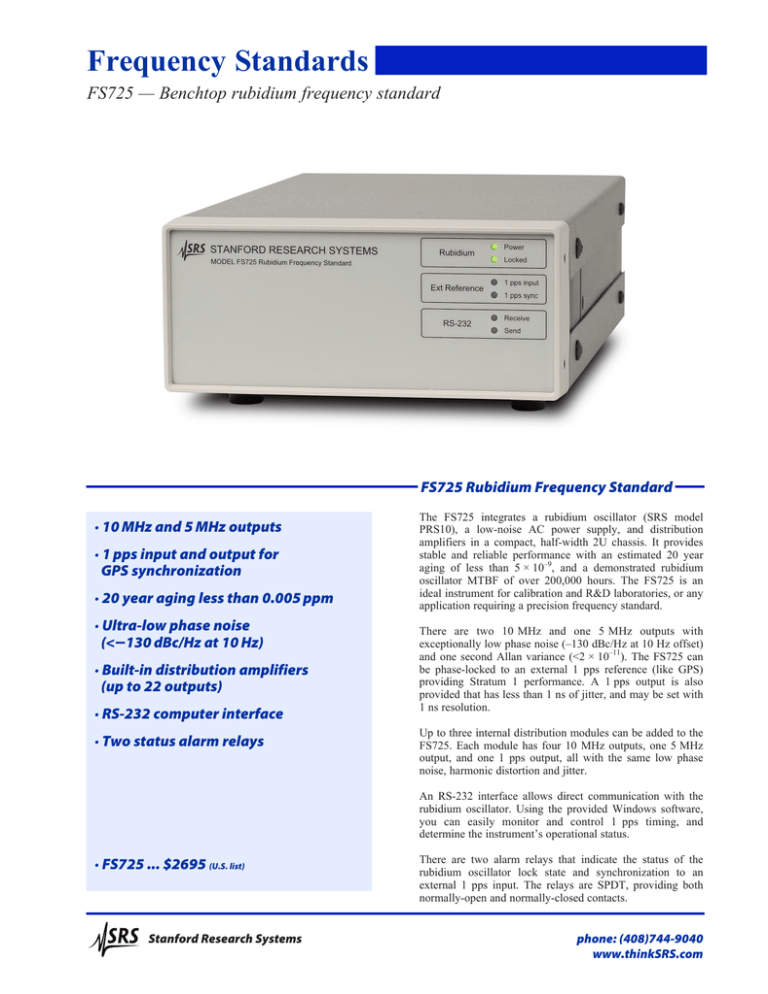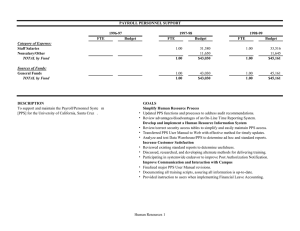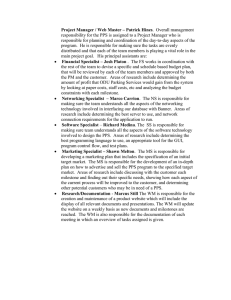Frequency Standards - Stanford Research Systems
advertisement

Frequency Standards FS725 — Benchtop rubidium frequency standard FS725 Rubidium Frequency Standard · 10 MHz and 5 MHz outputs · 1 pps input and output for GPS synchronization · 20 year aging less than 0.005 ppm · Ultra-low phase noise (<−130 dBc/Hz at 10 Hz) · Built-in distribution amplifiers (up to 22 outputs) · RS-232 computer interface · Two status alarm relays The FS725 integrates a rubidium oscillator (SRS model PRS10), a low-noise AC power supply, and distribution amplifiers in a compact, half-width 2U chassis. It provides stable and reliable performance with an estimated 20 year aging of less than 5 × 10–9, and a demonstrated rubidium oscillator MTBF of over 200,000 hours. The FS725 is an ideal instrument for calibration and R&D laboratories, or any application requiring a precision frequency standard. There are two 10 MHz and one 5 MHz outputs with exceptionally low phase noise (–130 dBc/Hz at 10 Hz offset) and one second Allan variance (<2 × 10–11). The FS725 can be phase-locked to an external 1 pps reference (like GPS) providing Stratum 1 performance. A 1 pps output is also provided that has less than 1 ns of jitter, and may be set with 1 ns resolution. Up to three internal distribution modules can be added to the FS725. Each module has four 10 MHz outputs, one 5 MHz output, and one 1 pps output, all with the same low phase noise, harmonic distortion and jitter. An RS-232 interface allows direct communication with the rubidium oscillator. Using the provided Windows software, you can easily monitor and control 1 pps timing, and determine the instrument’s operational status. · FS725 ... $2695 (U.S. list) There are two alarm relays that indicate the status of the rubidium oscillator lock state and synchronization to an external 1 pps input. The relays are SPDT, providing both normally-open and normally-closed contacts. Stanford Research Systems phone: (408)744-9040 www.thinkSRS.com FS725 Specifications Output Output frequencies Amplitude 1 pps pulse amplitude Phase noise (SSB) 10 MHz sine, 5 MHz sine, 10 µs wide 1 pps pulse 0.5 Vrms, ±10 % 2.5 V into 50 Ω, 5 V into High-Z loads <–130 dBc/Hz (10 Hz) <–140 dBc/Hz (100 Hz) <–150 dBc/Hz (1 kHz) <–155 dBc/Hz (10 kHz) FS725 Single Sideband Phase Noise -100 -110 dBc/Hz -120 -130 -140 -150 -160 1 10 100 1k 10 k 100 k 10 MHz outputs 5 MHz output 1 pps output Optional outputs Alarm relays Rb lock 1 pps RS-232 level pulses (0 to 5 VDC). If an external 1 pps input is applied, lock is maintained between the 1 pps input and 1 pps output, with computer adjustable time constant from 8 minutes to 18 hours. Two 50 Ω isolated sine outputs One 50 Ω sine output One 50 Ω pulse output Each option board provides four 10 MHz, one 5 MHz, and one 1 pps outputs. Up to 3 boards can be installed. Max. current, 3 A. SPDT, normally open or normally closed. May be wired in parallel with other relays to “wire-or” a single alarm. Relay status matches the front-panel “Locked” LED. Relay status matches the front-panel “1 pps sync” LED. 9-pin connector configured as DCE, 9600 baud. Windows RbMon software is provided. Frequency Offset from Carrier (Hz) Spurious<–100 dBc (100 kHz BW) Harmonics<–60 dBc Accuracy at shipment ±5 × 10–11 Aging (after 30 days) Monthly <5 × 10–11 (<2.5 × 10–11 with opt. C) Yearly <5 × 10–10 20 years (typ.) 5 × 10–9 Short-term stability <2 × 10–11 (1 s) (Allan variance) <1 × 10–11 (10 s) <2 × 10–12 (100 s) Holdover 72 hour Stratum 1 level (1 × 10–11) Frequency retrace ±5 × 10–11 (72 hrs. off, then 72 hrs. on) Settability<5 × 10–12 Trim range ±2 × 10–9 (0 to 5 VDC) ±0.5 ppm (via RS-232) Warm-up time <6 minutes (time to lock) <7 minutes (time to 1 × 10–9) Front-Panel Indicators (Green LEDs) Power Locked 1 pps input 1 pps sync Receive Send “On” when AC power is applied “On” when frequency is locked to Rb Blinks with each 1 pps reference input applied to rear panel “On” when 1 pps output is synchronized within ±1 µs of 1 pps input Blinks when RS-232 characters are received by FS725 Blinks when RS-232 characters are sent by FS725 Environmental Operating temperature Temperature stability Storage temperature Magnetic field Relative humidity +10 °C to +40 °C ∆f/f < ±1 × 10–10 (+10 °C to +40 °C) –55 °C to +85 °C ∆f/f < 2 × 10–10 (1 Gauss field reversal) 95 % (non-condensing) General AC power Dimensions, weight Warranty 90 to 132 VAC or 175 to 264 VAC, 47 to 63 Hz, 50 W 8.5" × 3.5" × 13" (WHL), 9 lbs. One year parts and labor on defects Ordering Information FS725 Option 01 Option 02 Option 03 Option C O725RMD O725RMS Benchtop Rb frequency standard $2695 Distribution amplifier (6 outputs) $495 Distribution amplifier (12 outputs) $995 Distribution amplifier (18 outputs) $1495 Low monthly aging (<2.5 × 10–11) $495 Double rack mount kit $100 Single rack mount kit $100 Rear-Panel Connections Frequency adjust 1 pps input 0 to 5 VDC adjusts frequency by ±0.002 ppm (normally unconnected) One 100 kΩ input. Requires CMOS Stanford Research Systems FS725 rear panel (with Opt. 03) phone: (408)744-9040 www.thinkSRS.com


